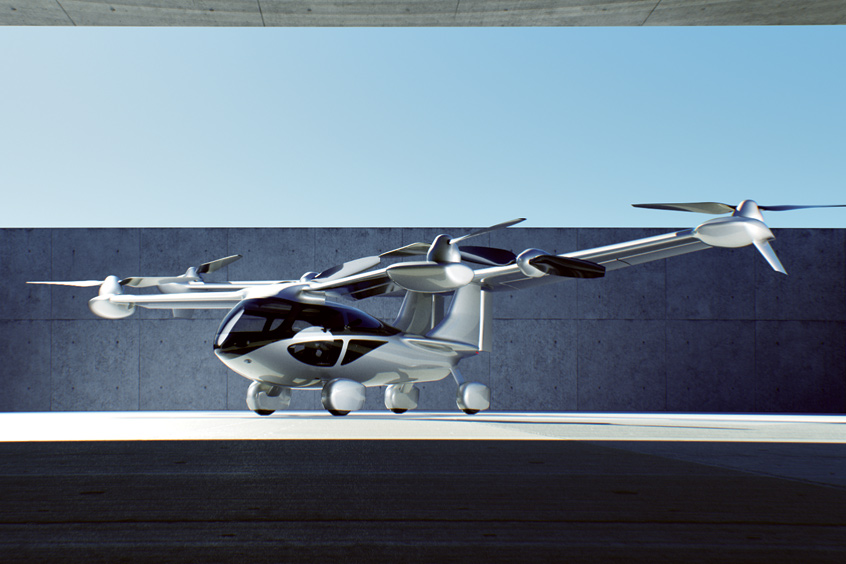ACE 2026 - The home of global charter.
 The bimonthly news publication for aviation professionals.
The bimonthly news publication for aviation professionals.

The first fully-functional prototype of the Aska A5 drive and fly eVTOL vehicle has made its debut at the CES 2023 exhibition in Las Vegas.
The size of an SUV, the Aska A5 is a four seat electric vehicle that can travel by road and up to 250 miles by air on a single charge. The company will also launch an on demand ride service in 2026 that will feature a fleet of Aska vehicles operating in major cities and their surroundings.
"Our unveil at CES represents something that has never been accomplished in the world, but which humans have dreamed of for decades: a fully functional, full scale prototype of a drive and fly eVTOL, a real flying car. We're making history with Aska and defining the next 100 years of transportation," says co-founder and CEO Guy Kaplinsky. "Aska is positioned as a new generation vehicle that combines the convenience of an automobile with the ease and efficiency of VTOL and STOL flight. There is also significant business potential in emergency response use, military use, as well as on demand ride-sharing mobility services."
Aska requires minimum updates to the current infrastructure. To perform a vertical take off or landing, it requires only a compact space such as a helipad or vertiport. The vehicle fits in existing parking spaces, it can be charged at home and at EV charging stations, and the range extender engine runs on premium gasoline purchased at existing automotive gas stations.
The company is developing an affordable on demand ride-sharing service that utilises its eVTOL vehicles. Targeting availability in major cities and surrounding areas by 2026, Aska's ride-sharing programme will have certified pilots pick ride-share customers up at their homes and fly them to their destinations. The company has launched early-bird sign-up free registration for Aska On-Demand.
Powering the Aska A5 is a proprietary power system that features lithium-ion battery packs and a gasoline engine that acts as an onboard range extender. This dual energy source delivers a 250 mile flight range and drastically increases power source reliability.
In drive mode, Aska packs in-wheel motor technology, allowing all four wheels to be placed outside the fuselage for all-wheel-drive traction, better aerodynamics and maximised interior space to comfortably seat four passengers.
In flying mode, the vehicle's wings with six rotors unfold, allowing the vehicle to either take off vertically or perform conventional runway take offs. The large wing is optimised for gliding, smooth landings and efficient energy consumption, while each tilt rotor is utilised for vehicle control.
Aska can take off in two ways: one is a vertical take off and landing (VTOL) from a compact space like a helipad. The other is a conventional runway take off and landing, which can improve the vehicle's energy consumption efficiency.
"In the US alone, there are around 15,000 airfields with runways," says co-founder, chair and COO Maki Kaplinsky. "Our innovative engineering enables Aska to take off from a runway super fast using our unique in-wheel motor technology. This is a revolution in aviation, enabling Aska to take off in less than five seconds with a runway of 250 ft, which brings the closest experience to a F-18 Super Hornet fighter jet taking off from an aircraft carrier for our customers. Pilots will have plenty of options of how and where to fly. Its revolutionary drive and fly design enables us to use existing infrastructure and provide last mile transportation. Aska lets people drive, fly and then drive to their final destination in one vehicle. This drive and fly approach will enable air mobility to be more easily and cost-effectively adopted."
Aska is designed for the highest safety standards. For example, it has large wings and, in the event of an emergency, the large wings can glide the craft to a safe landing. Aska is equipped with dual energy sources, both batteries and an engine. The six propellers ensure better redundancy for safe landings. The best-in-class hybrid propulsion system provides a minimum of 30 minutes reserve flight time, which is a critical requirement by the FAA today. Aska also includes a ballistic parachute in case of emergency to save the whole aircraft.
In 2020, Aska signed a Space Act Agreement with NASA to advance its participation in the Advanced Air Mobility National Campaign, jointly organised by the FAA. In 2022 the FAA accepted Aska through its intake board, and the company is progressing towards type certification. Full-scale flight testing will start after the CES.
Subject to standard regulatory approval and certification, the Aska A5 is targeted for commercialisation 2026.